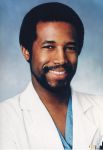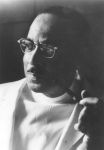A healer beyond the operating room
Dr. Benjamin Carson is professor of Neurosurgery, Oncology, Plastic Surgery and Pediatrics; director, Division of Pediatric Neurosurgery; and co-director, The Johns Hopkins Craniofacial Center. His work focuses on traumatic brain injuries, brain and spinal cord tumors, achondroplasia, neurological and congenital disorders, craniosynostosis, epilepsy and trigeminal neuralgia. He is also interested in maximizing the intellectual potential of every child.
 |
|
DR. BENJAMIN CARSON
|
An internationally renowned physician, Carson has authored over more than neurosurgical publications, along with three best-selling books, and has been awarded 38 honorary doctorate degrees and dozens of national merit citations. He is certified by the American Board of Neurological Surgery, and by the American Board of Pediatric Neurological Surgery.
Carson majored in psychology at Yale and graduated from the University Of Michigan School Of Medicine. He went on to complete both his internship in general surgery and residency in neurological surgery at The Johns Hopkins Medical Institutions. In addition, he served as senior registrar in neurosurgery at the Sir Charles Gairdner Hospital, Queen Elizabeth II Medical Center in Western Australia.
Carson received the Presidential Medal of Freedom at the White House June 19, 2008. While everyone acknowledges his medical and scientific achievements, President Bush seemed even more impressed with Carson’s commitment to the communities in which he lives.
“He is working to be an influence to young people,” said President Bush.
“He and his wife Candy have started an organization that offers college scholarships to students across America. The child of Detroit who once saw a grim future became a scholar, healer and leader.”
“I hope that it encourages young people all over the country to recognize that it’s not where you come from, it’s where you’re going that counts,” said Carson.
His family—wife Candy, three children and mother—joined him at the White House. Immediately following the ceremony there was a reception for the honorees. As soon as the reception was over, Carson headed straight to Baltimore to perform two surgeries.
Carson believes that people are more important than the prizes. “Whether we get medals and special recognition really is not that important. What’s really important is that you do the very best that you can, that you take personal responsibility. Not only in your own life, but in those who are in your sphere of influence,” he said.
The Medal of Freedom was established by President Truman in 1945 to recognize civilians for their efforts during World War II. The award was reinstated by President Kennedy in 1963 to honor distinguished service. It is given to those deemed to have made remarkable contributions to the security or national interests of the United States, world peace, culture or other private or public endeavors.
‘Something the Lord made’
Vivien T. Thomas, L.L.D. was a supervisor of surgical laboratories and an instructor of surgery at Johns Hopkins University School of Medicine. He was instrumental in the development of the “blue baby” operation in 1944, with surgeon Alfred Blalock and pediatric cardiologist Helen Taussig. This lifesaving operation to correct a congenital heart defect in babies became a major landmark in pediatric cardiac surgery.
 |
|
VIVIEN T. THOMAS
|
Thomas was born in New Iberia, La. The grandson of a slave, he attended Pearl High School (which was named for Union sympathizer Joshua Fenton Pearl and is now known as Pearl Cohn Magnet High School) in Nashville in the 1920s. Even though it was part of a racially segregated system, the school provided him with a decent education. Thomas had hoped to go to college and study to become a doctor, but the Great Depression derailed his plans.
Thomas began his career in medicine in 1930, as an assistant in the laboratory of Alfred Blalock at Vanderbilt University where Dr. Blalock trained him as his surgical assistant.
Thomas was classified, and paid, as a janitor, despite the fact that by the mid-1930s he was doing the work of a post-doctoral researcher in Blalock’s lab. Thomas’ intelligence and outstanding ability as a researcher and surgical assistant was so impressive, that Blalock requested Thomas to follow him to Johns Hopkins University in 1941.
During Thomas’ long year career at Johns Hopkins, he developed several operative techniques, designed surgical instruments, and supervised the surgical laboratories for over 35 years.
Many of the surgeons Thomas trained credit him with teaching them the surgical technique that placed them at the forefront of medicine in the U.S. His surgical technique was so skilled and flawless, that after examining the nearly undetectable suture line from a complex operation, Blalock remarked, “Vivien, this looks like something the Lord made.”
Although Thomas never received a formal degree in medicine, his enormous contributions to surgery and surgical education were officially recognized in 1976, when he was awarded the honorary Doctor of Laws degree by Johns Hopkins University. Thomas died Nov. 26, 1985. Today his portrait hangs in the lobby of the Blalock Building at The Johns Hopkins Hospital across from the image of Alfred Blalock.
(Compiled by Franki L. Williams for the New Pittsburgh Courier.)